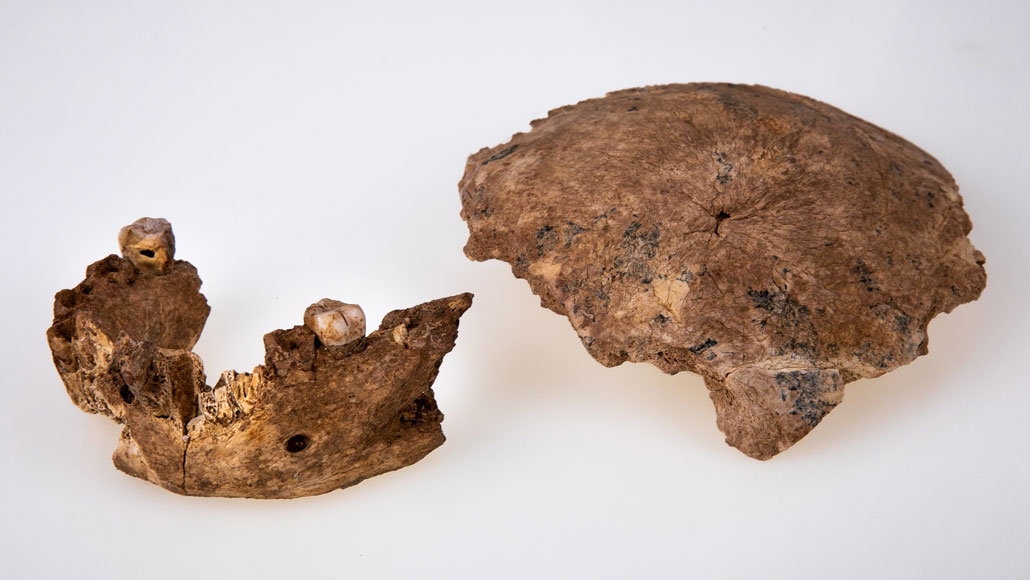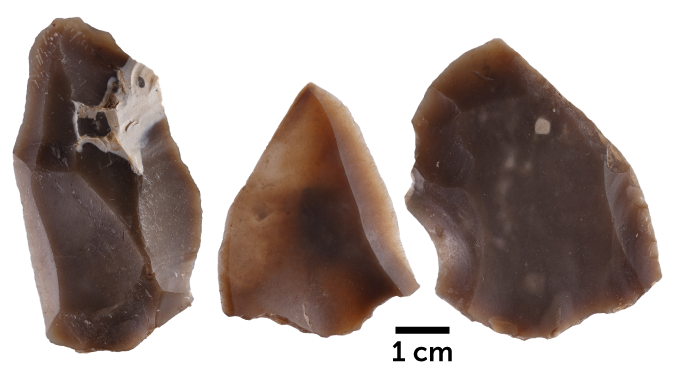Israeli fossil finds reveal a new hominid group, Nesher Ramla Homo
A previously unknown Stone Age population further complicates the human family tree

Parts of a jaw (left) and a braincase (right), found at Israel’s Nesher Ramla site, represent an ancient hominid population that contributed to the evolution of European Neandertals and possibly some ancient Homo groups in East Asia, researchers say.
Avi Levin and Ilan Theiler/Sackler Faculty of Medicine/Tel Aviv Univ.
By Bruce Bower
- More than 2 years ago
Read another version of this article at Science News Explores
Excavations in an Israeli sinkhole have unveiled a previously unknown Stone Age hominid group that contributed to the evolution of the human genus, Homo. Inhabitants of a site called Nesher Ramla, who lived about 140,000 to 120,000 years ago, join Neandertals and Denisovans as a third Eurasian Homo population that culturally mingled with and possibly interbred with ancient Homo sapiens, researchers say.
Hominid fossils previously excavated at three Israeli caves, which date to as early as around 420,000 years ago, probably also belong to the ancient population represented by the Nesher Ramla finds, says an international team led by paleoanthropologist Israel Hershkovitz.
The researchers don’t assign a species name to what they call Nesher Ramla Homo. Genetic and cultural mixing of Eurasian Homo groups during the Middle Pleistocene period — which ran from about 789,000 to 130,000 years ago — occurred too frequently to enable the evolution of a distinct species in this case, the team says.
Two studies in the June 25 Science, one led by Hershkovitz, of Tel Aviv University, and the other led by archaeologist Yossi Zaidner of the Hebrew University of Jerusalem, describe the new finds.
The fossils further complicate the human family tree, which has grown more complex in recent years with additions such as H. naledi from South Africa and the proposed H. luzonensis from the Philippines (SN: 9/10/15; SN: 4/10/19).
“Nesher Ramla Homo was one of the last survivors of an ancient group of [hominids] that contributed to the evolution of European Neandertals and East Asian Homo populations,” Hershkovitz says.
Work at Nesher Ramla uncovered five pieces of a braincase and a nearly complete lower jaw containing a molar tooth. These fossils in some ways resemble Neandertals and in others recall certain fossils often classified as Homo heidelbergensis, a pre-Neandertal species thought to have occupied parts of Africa, Europe and possibly East Asia starting around 700,000 years ago (SN: 5/15/19).
In the fossil-bearing sediment, Hershkovitz’s team excavated roughly 6,000 stone artifacts and several thousand bones of gazelles, horses, tortoises and other animals. Some of those bones contained stone-tool marks made during meat removal.

Combinations of traits on some Chinese Homo fossils, including a child’s jaw dating to possibly more than 200,000 years ago, resemble the look of the new Israeli fossils, Hershkovitz says (SN: 1/16/19). Ancient Homo groups with roots at Nesher Ramla may have reached East Asia and perhaps mated with some groups already living there, he speculates.
But Nesher Ramla Homo didn’t have to go as far as East Asia to interact with other hominid groups. Stone tools found with Nesher Ramla Homo fossils match implements of comparable age made from prepared chunks of rock by nearby H. sapiens (SN: 1/25/18). Nesher Ramla Homo and H. sapiens must have exchanged stone-tool making knowledge, and possibly interbred, Hershkovitz says. Attempts to extract DNA from the Nesher Ramla fossils, which would reveal whether interbreeding took place, have failed.
It’s intriguing that stone tools usually associated with H. sapiens were found with such distinctive-looking fossils, says paleoanthropologist John Hawks of the University of Wisconsin–Madison, who did not participate in the new research. “That’s not a smoking gun proving there were close interactions between Nesher Ramla Homo and Homo sapiens, but it’s very suggestive.”
Evidence from Nesher Ramla fits a scenario in which the Homo genus evolved as closely related Middle Pleistocene populations and species, including Neandertals, Denisovans and H. sapiens. Groups based in livable southern regions moved into much of Europe and Asia during relatively warm, wet stretches, writes paleoanthropologist Marta Mirazón Lahr of the University of Cambridge in a commentary published with the new studies. These ancient groups interbred, became fragmented, died out or recombined with other Homo groups along the way, producing a variety of skeletal looks seen in European and East Asian Homo fossils, Lahr suggests.







